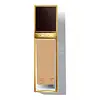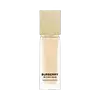Tom Ford Shade and Illuminate Soft Radiance Foundation SPF 50 Versus Burberry Beyond Wear Perfecting Matte Foundation
What's inside
What's inside
 Key Ingredients
Key Ingredients

 Benefits
Benefits

 Concerns
Concerns

 Ingredients Side-by-side
Ingredients Side-by-side

Phenylbenzimidazole Sulfonic Acid 2.7%
UV AbsorberEthylhexyl Methoxycinnamate 6.7%
UV AbsorberEthylhexyl Salicylate 4.5%
UV AbsorberZinc Oxide 3.8%
Cosmetic ColorantWater
Skin ConditioningDimethicone
EmollientPhenyl Trimethicone
Skin ConditioningButylene Glycol
HumectantGlycerin
HumectantPolymethylsilsesquioxane
Lauryl PEG-9 Polydimethylsiloxyethyl Dimethicone
Skin ConditioningHdi/PPG/Polycaprolactone Crosspolymer
Trimethylsiloxysilicate/Dimethiconol Crosspolymer
Tromethamine
BufferingPolysilicone-11
Hexyl Laurate
EmollientCetyl PEG/PPG-10/1 Dimethicone
EmulsifyingNeopentyl Glycol Diheptanoate
EmollientHydroxyethyl Urea
HumectantTremella Fuciformis Sporocarp Extract
AntioxidantHylocereus Undatus Fruit Extract
Skin ConditioningEuterpe Oleracea Fruit Oil
Skin ConditioningCarapa Guaianensis Seed Oil
Skin ConditioningLavandula Angustifolia Oil
MaskingSapindus Mukorossi Fruit Extract
Skin ConditioningMorinda Citrifolia Fruit Extract
Skin ConditioningPolyglyceryl-4 Isostearate
EmulsifyingCopaifera Officinalis Resin
MaskingTriolein
Skin ConditioningCaprylic/Capric Triglyceride
MaskingBetaine
HumectantCaffeine
Skin ConditioningAcetyl Hexapeptide-8
HumectantTocopheryl Acetate
AntioxidantTrehalose
HumectantHydrogenated Coco-Glycerides
EmollientCaesalpinia Spinosa Gum
Skin ConditioningTrimethylsiloxysilicate
EmollientPolyhydroxystearic Acid
EmulsifyingLecithin
EmollientGlyceryl Stearate
EmollientTriethoxycaprylylsilane
Laureth-7
EmulsifyingSodium Chloride
MaskingDisteardimonium Hectorite
StabilisingMethicone
EmollientLinoleic Acid
CleansingPhospholipids
Skin ConditioningStearyl Alcohol
EmollientCetearyl Alcohol
EmollientAmmonium Polyacryloyldimethyl Taurate
Emulsion StabilisingSodium Hyaluronate
HumectantTocopherol
AntioxidantTriethyl Citrate
MaskingPalmitic Acid
EmollientPhytosteryl Canola Glycerides
Skin ConditioningStearic Acid
CleansingOleic Acid
EmollientPolysorbate 80
EmulsifyingPolysorbate 20
EmulsifyingBehenyl Alcohol
EmollientSilica
AbrasiveLinalool
PerfumingDisodium EDTA
BHT
AntioxidantPotassium Sorbate
PreservativeSodium Dehydroacetate
PreservativePhenoxyethanol
PreservativeMica
Cosmetic ColorantCI 77891
Cosmetic ColorantCI 77491
Cosmetic ColorantCI 77492
Cosmetic ColorantCI 77499
Cosmetic ColorantPhenylbenzimidazole Sulfonic Acid 2.7%, Ethylhexyl Methoxycinnamate 6.7%, Ethylhexyl Salicylate 4.5%, Zinc Oxide 3.8%, Water, Dimethicone, Phenyl Trimethicone, Butylene Glycol, Glycerin, Polymethylsilsesquioxane, Lauryl PEG-9 Polydimethylsiloxyethyl Dimethicone, Hdi/PPG/Polycaprolactone Crosspolymer, Trimethylsiloxysilicate/Dimethiconol Crosspolymer, Tromethamine, Polysilicone-11, Hexyl Laurate, Cetyl PEG/PPG-10/1 Dimethicone, Neopentyl Glycol Diheptanoate, Hydroxyethyl Urea, Tremella Fuciformis Sporocarp Extract, Hylocereus Undatus Fruit Extract, Euterpe Oleracea Fruit Oil, Carapa Guaianensis Seed Oil, Lavandula Angustifolia Oil, Sapindus Mukorossi Fruit Extract, Morinda Citrifolia Fruit Extract, Polyglyceryl-4 Isostearate, Copaifera Officinalis Resin, Triolein, Caprylic/Capric Triglyceride, Betaine, Caffeine, Acetyl Hexapeptide-8, Tocopheryl Acetate, Trehalose, Hydrogenated Coco-Glycerides, Caesalpinia Spinosa Gum, Trimethylsiloxysilicate, Polyhydroxystearic Acid, Lecithin, Glyceryl Stearate, Triethoxycaprylylsilane, Laureth-7, Sodium Chloride, Disteardimonium Hectorite, Methicone, Linoleic Acid, Phospholipids, Stearyl Alcohol, Cetearyl Alcohol, Ammonium Polyacryloyldimethyl Taurate, Sodium Hyaluronate, Tocopherol, Triethyl Citrate, Palmitic Acid, Phytosteryl Canola Glycerides, Stearic Acid, Oleic Acid, Polysorbate 80, Polysorbate 20, Behenyl Alcohol, Silica, Linalool, Disodium EDTA, BHT, Potassium Sorbate, Sodium Dehydroacetate, Phenoxyethanol, Mica, CI 77891, CI 77491, CI 77492, CI 77499
Water
Skin ConditioningDimethicone
EmollientTrimethylsiloxysilicate
EmollientMethyl Trimethicone
Skin ConditioningGlycerin
HumectantSorbitan Isostearate
EmulsifyingCaprylyl Dimethicone Ethoxy Glucoside
EmulsifyingButylene Glycol
HumectantVinyl Dimethicone/Methicone Silsesquioxane Crosspolymer
Zinc Stearate
Cosmetic ColorantCellulose
AbsorbentStearalkonium Hectorite
Gel FormingSodium Chloride
MaskingRosa Damascena Flower Water
MaskingPolysilicone-11
Triethoxycaprylylsilane
Alcohol
AntimicrobialSodium Benzoate
MaskingPotassium Sorbate
PreservativeSodium Dehydroacetate
Preservative3-O-Ethyl Ascorbic Acid
Skin ConditioningPropanediol
SolventParfum
MaskingTocopheryl Acetate
AntioxidantSodium Citrate
BufferingBambusa Arundinacea Stem Powder
AbrasiveTrimethylpentanediol/Adipic Acid/Glycerin Crosspolymer
Skin ConditioningLauryl Dimethicone
Skin ConditioningPhytic Acid
Bombax Malabaricum Flower Extract
HumectantCamellia Sinensis Leaf Extract
AntimicrobialRosa Damascena Flower Extract
MaskingCitric Acid
Buffering1,2-Hexanediol
Skin ConditioningCaprylyl Glycol
EmollientCI 77891
Cosmetic ColorantIron Oxides
Water, Dimethicone, Trimethylsiloxysilicate, Methyl Trimethicone, Glycerin, Sorbitan Isostearate, Caprylyl Dimethicone Ethoxy Glucoside, Butylene Glycol, Vinyl Dimethicone/Methicone Silsesquioxane Crosspolymer, Zinc Stearate, Cellulose, Stearalkonium Hectorite, Sodium Chloride, Rosa Damascena Flower Water, Polysilicone-11, Triethoxycaprylylsilane, Alcohol, Sodium Benzoate, Potassium Sorbate, Sodium Dehydroacetate, 3-O-Ethyl Ascorbic Acid, Propanediol, Parfum, Tocopheryl Acetate, Sodium Citrate, Bambusa Arundinacea Stem Powder, Trimethylpentanediol/Adipic Acid/Glycerin Crosspolymer, Lauryl Dimethicone, Phytic Acid, Bombax Malabaricum Flower Extract, Camellia Sinensis Leaf Extract, Rosa Damascena Flower Extract, Citric Acid, 1,2-Hexanediol, Caprylyl Glycol, CI 77891, Iron Oxides
Ingredients Explained
These ingredients are found in both products.
Ingredients higher up in an ingredient list are typically present in a larger amount.
Butylene Glycol (or BG) is used within cosmetic products for a few different reasons:
Overall, Butylene Glycol is a safe and well-rounded ingredient that works well with other ingredients.
Though this ingredient works well with most skin types, some people with sensitive skin may experience a reaction such as allergic rashes, closed comedones, or itchiness.
Learn more about Butylene GlycolCi 77891 is a white pigment from Titanium dioxide. It is naturally found in minerals such as rutile and ilmenite.
It's main function is to add a white color to cosmetics. It can also be mixed with other colors to create different shades.
Ci 77891 is commonly found in sunscreens due to its ability to block UV rays.
Learn more about CI 77891Dimethicone is a type of synthetic silicone created from natural materials such as quartz.
What it does:
Dimethicone comes in different viscosities:
Depending on the viscosity, dimethicone has different properties.
Ingredients lists don't always show which type is used, so we recommend reaching out to the brand if you have questions about the viscosity.
This ingredient is unlikely to cause irritation because it does not get absorbed into skin. However, people with silicone allergies should be careful about using this ingredient.
Note: Dimethicone may contribute to pilling. This is because it is not oil or water soluble, so pilling may occur when layered with products. When mixed with heavy oils in a formula, the outcome is also quite greasy.
Learn more about DimethiconeGlycerin is already naturally found in your skin. It helps moisturize and protect your skin.
A study from 2016 found glycerin to be more effective as a humectant than AHAs and hyaluronic acid.
As a humectant, it helps the skin stay hydrated by pulling moisture to your skin. The low molecular weight of glycerin allows it to pull moisture into the deeper layers of your skin.
Hydrated skin improves your skin barrier; Your skin barrier helps protect against irritants and bacteria.
Glycerin has also been found to have antimicrobial and antiviral properties. Due to these properties, glycerin is often used in wound and burn treatments.
In cosmetics, glycerin is usually derived from plants such as soybean or palm. However, it can also be sourced from animals, such as tallow or animal fat.
This ingredient is organic, colorless, odorless, and non-toxic.
Glycerin is the name for this ingredient in American English. British English uses Glycerol/Glycerine.
Learn more about GlycerinPolysilicone-11 is a film-forming silicone that creates a non-tacky and matte finish on the skin. It's commonly used to improve texture, absorb excess oil, and help active ingredients spread evenly.
Due to its "rubber-like" structure, it stays on the skin's surface instead of being absorbed. On the skin, it creates a flexible layer that enhances wearability and stability.
Potassium Sorbate is a preservative used to prevent yeast and mold in products. It is commonly found in both cosmetic and food products.
This ingredient comes from potassium salt derived from sorbic acid. Sorbic acid is a natural antibiotic and effective against fungus.
Both potassium sorbate and sorbic acid can be found in baked goods, cheeses, dried meats, dried fruit, ice cream, pickles, wine, yogurt, and more.
You'll often find this ingredient used with other preservatives.
Learn more about Potassium SorbateChances are, you eat sodium chloride every day. Sodium Chloride is also known as table salt.
This ingredient has many purposes in skincare: thickener, emulsifier, and exfoliator.
You'll most likely find this ingredient in cleansers where it is used to create a gel-like texture. As an emulsifier, it also prevents ingredients from separating.
There is much debate on whether this ingredient is comedogenic. The short answer - comedogenic ratings don't tell the whole story. Learn more about comegodenic ratings here.
The concensus about this ingredient causing acne seems to be divided. Research is needed to understand if this ingredient does cause acne.
Scrubs may use salt as the primary exfoliating ingredient.
Learn more about Sodium ChlorideThis ingredient is a preservative with antimicrobial properties. It is the sodium salt of dehydroacetic acid.
It is especially effective at preventing bacterial and fungal growth in low concentrations.
Tocopheryl Acetate is AKA Vitamin E. It is an antioxidant and protects your skin from free radicals. Free radicals damage the skin by breaking down collagen.
One study found using Tocopheryl Acetate with Vitamin C decreased the number of sunburned cells.
Tocopheryl Acetate is commonly found in both skincare and dietary supplements.
Learn more about Tocopheryl AcetateTriethoxycaprylylsilane is a silicone used to bind and stabilize ingredients.
As an emulsifier, it helps prevent ingredients from separating. This can help elongate the shelf life of products.
Triethoxycaprylylsilane is often used to coat mineral sunscreens ingredients to help give a better feel. It also helps reduce oxidative stress in sunscreens.
Learn more about TriethoxycaprylylsilaneThis silicone is an emollient. Emollients create a thin film on the skin to prevent moisture from escaping.
It is not soluble in water and helps increase water-resistance in products.
According to a manufacturer, it can blend seamlessly with silicone oils, such as Cyclopentasiloxane.
Learn more about TrimethylsiloxysilicateWater. It's the most common cosmetic ingredient of all. You'll usually see it at the top of ingredient lists, meaning that it makes up the largest part of the product.
So why is it so popular? Water most often acts as a solvent - this means that it helps dissolve other ingredients into the formulation.
You'll also recognize water as that liquid we all need to stay alive. If you see this, drink a glass of water. Stay hydrated!
Learn more about Water